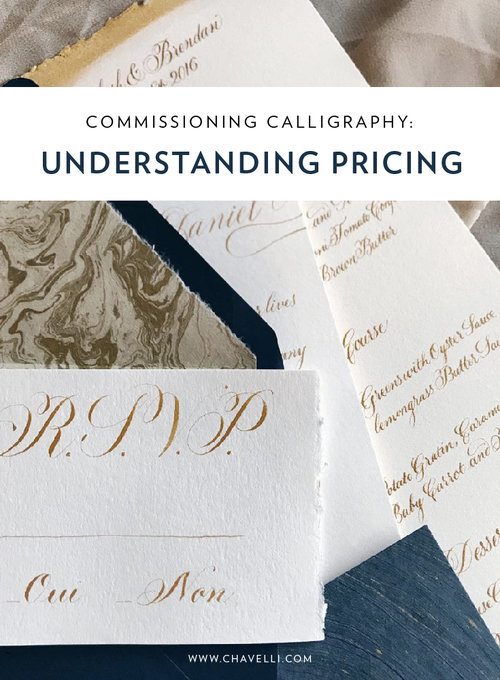Commissioning Calligraphy Part 3: Understanding Pricing
If you missed part 1 of this series on calligraphy, check it out here.
Understanding Calligraphy Pricing
Paying for Eloquence
As we have established in previous posts, calligraphy is an art. It’s a beautiful, handmade craft that is perfected through hours and hours of dedicated practice hunched over paper with pen in hand.
If you are in hot pursuit of a calligrapher for your wedding, your parent’s 50th anniversary, or any other lifetime event, keep in mind that you are hiring a highly trained professional with a skilled set of hands. Believe me, you can’t find that kind of value and expertise in just anyone and it will be reflected in their pricing.
Envelope Pricing
While calligraphy can be used for many types of stationery and correspondence, the most obvious use these days is for addressing envelopes. Envelopes are typically priced out per line or per envelope, starting at around $4 per envelope, with add-ons for each additional upgrade. Upgrades may include a more complex calligraphy style, custom inks, center alignment, etc. And you know it—like with everything else—the more add-ons the higher the cost. Upgrades aren’t just arbitrary ways to charge you more money, they are reflective of the additional time or materials required.
This type of pricing structure (per piece with add-ons) is typical for straightforward pieces like envelopes, place cards, spot calligraphy and the like.
Designed Commissions
If you're commissioning a piece that requires design—in this case meaning a back and forth process between you and the artist discussing the artwork and layout—expect to pay for this in addition to the calligraphy. Certificate commissions, invitations, complex signage and the like are things that you would want to look at, review and give feedback on before the final piece is made, so understandably this extra time requires extra charges.
On top of the design fee, you can expect to pay between $1-5 per word on the production (the actual writing of the calligraphy) in addition to any materials.
Set-up Fees
One thing that may also come as a surprise is that many calligraphers charge a setup fee or a minimum project fee to cover the time it takes to prepare for your project. This includes things like testing the requested paper or material to make sure the ink works on that surface and doesn’t bleed or feather into the paper. This could also include any customized colors that would need to be mixed by hand, with much trial and error to get it just right. All these steps would be done to ensure that your project can be carried out just the way you want.
If you think it's silly that your project of 10 place cards requires a set-up fee, think about it this way—a calligrapher has to do the same amount of testing and prep-work for your project whether you need one envelope or 200.
Bulk Pricing Doesn't Exist
Finally, I want to jump in here and advise that you abandon the idea of bulk pricing when it comes to handmade calligraphy. It may seem logical to request a discounted rate for large quantities of writing, but in this case the reasoning doesn’t hold up.
There’s no such thing as economies of scale with hand-made, professional calligraphy work!
It may only take 30 seconds to create a piece of writing, but that time does not decrease with each additional piece—in fact, it increases as hand fatigue sets in and breaks need to be taken. Plus, it’s worth so much more than 30 seconds of time. Each individual piece is handwritten by a professional who knows how to create the exact style and feel of what you want. And that is ultimately what you are paying for.
There is a range of calligraphy pricing depending on your needs and your calligrapher’s skill and experience. You supply the materials (envelopes, signage, etc.), but your calligrapher does the masterful part of making them look eloquent and beautiful so the investment is totally worth it!
Next up: Working With Your Calligrapher




